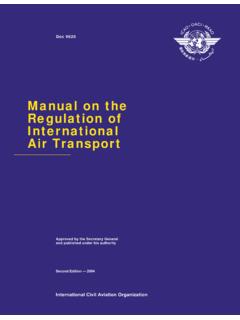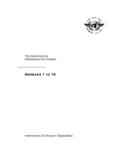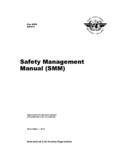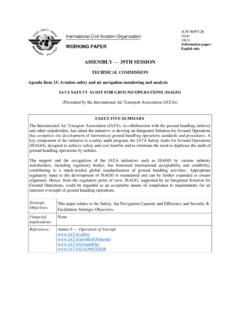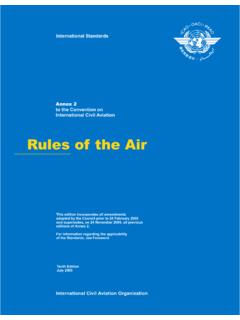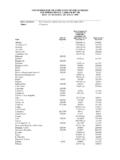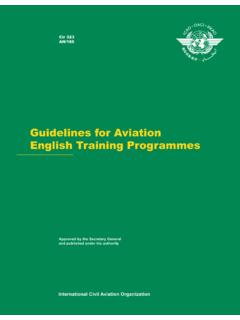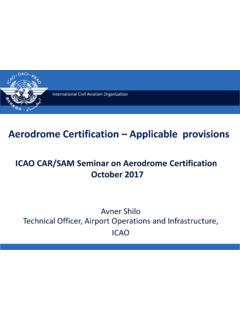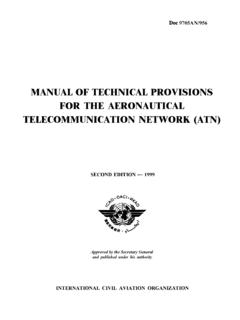Transcription of Search and Rescue (SAR) Best Practices - ICAO
1 Virtual Workshop on the establishment of an effective Search and Rescue (SAR) organization SAR Best Practices Albert Aidoo Taylor (RO-ATM & SAR, WACAF) / Keziah Ogutu (RO-ATM & SAR, ESAF). Search and Rescue (SAR). Organization and Management SAR System Concept Benefits of Services Global, National, Regional Systems Components of SAR System SAR as a System Rescue Co-ordination Center and Sub-Centers Training, Qualification, & Certification of SAR Professionals Building Professionals Training, Qualification, Certification Exercising Capability SAR Communications Basic Functions and Requirements Co-ordination of components of the SAR System SAR System Management & Organizational Improvement Planning and Resource Assessment, Analysis, and Implementation DOTMLPF Analysis 2.
2 SAR System Concept Overview Why Provide SAR? Benefits of SAR Services International SARA gencies International SAR Documents Global SAR Concept National and Regional Systems 3. Why Provide SAR? 4. Why Provide SAR? Benefits of SAR Services Reduction of loss of life and suffering Safe/ secure environment for maritime related industries, commerce, recreation, and travel Resource for initial response during natural disasters as integrated into national emergency management system Positive publicity about responses to SAR events Method of promoting co-operation between States Legal basis as a party to the International Convention for the Safety of Life at Sea (SOLAS) State provided SAR.
3 5. International SAR Agencies International maritime Organization (IMO). International Civil Aviation Organization (ICAO). Focus on SAFETY. Develop global SAR plans, procedures, techniques and training for SAR. Both envision a patchwork of SAR Regions (SRRs) encompassing globe with Rescue coordination centers responsible for assigned SRRs 6. International SAR Documents ICAO Convention / Annex 12. IMO SAR Convention SOLAS SAR Convention ICAO Regional SAR Plans ICAO/IMO InternationalAeronautical & and maritime SAR. IMO Global SAR Plan Manual (IAMSAR). National/Regional SARP lans National/Regional SARM anuals RCC/RSCP lansof Operation IAMSAR Manual Purpose Designed to harmonize Aeronautical and maritime SAR: Organization Procedures Equipment Comprehensive manual using standardized terminology and functions to ease aeronautical and maritime SAR Coordination Approved by ICAO and IMO.
4 8. IAMSAR Manual Description 3-volume Manual Volume 1 Organization and Management Volume 2 Mission Coordination Volume 3 Mobile Facilities Each Volume created for specific SAR system duties Each Volume can be used as stand-alone document or in conjunction with other two volumes 9. IAMSAR Manual VOLUME 1 Organization and Management Purpose Discusses global SAR system concept, establishment and improvement of national and regional SAR system, and cooperation with neighboring nations to provide effective and economical SAR services Primary User SAR System Managers 10. IAMSAR Manual VOLUME 2 Mission Co-ordination Purpose To assist personnel who plan and coordinate SAR operations and exercises Primary User Rescue Co-ordination Centers (RCCs) and Rescue Sub-centers (RSCs).
5 11. IAMSAR Manual VOLUME 3 Mobile Facilities Purpose To assist vessels and aircraft with performance of Search , Rescue , or on-scene coordinator function and with aspects of SAR that pertain to their own emergencies Primary User Rescue units, civil aircraft and vessels 12. IAMSAR Manual VOLUME 1 Organization and Management Chapter 1 SAR system concept overview Chapter 2 SAR system key components Chapter 3 Training, qualification, certification Chapter 4 SAR organization communications Chapter 5 SAR system management Chapter 6 Factors for improvement of SAR services 13. IAMSAR Manual VOLUME 2 Mission Co-ordination Chapter 1 Focused view of SAR system concept Chapter 2 SAR communications specifics Chapter 3 5 stages of SAR response Chapter 4 Search planning and evaluation concepts Chapter 5 Search techniques and operations Chapter 6 Rescue planning and operations Chapter 7 Emergency assistance other than SAR.
6 Chapter 8 Concluding SAR operations Appendices RCC Checklists, procedures, worksheets 14. IAMSAR Manual VOLUME 3 Mobile Facilities Section 1 Overview of SAR information Section 2 SAR response facilities Section 3 On-scene coordinator (OSC) or aircraft coordinator (ACO) specific information Section 4 SAR information for vessels, aircraft or other craft in need of assistance Appendices Specific information, forms and message formats for mobile facilities engaged in SAR operations 15. SAR System Management & Support Basic SAR System Functions Receive, acknowledge, and relay distress alerts Coordinate SAR response Conduct SAR operations The SAR System cannot be organized and effective without management and support 16.
7 SAR System Management & Support SAR System Managers must understand . the fundamentals of the system they are managing;. their own basic responsibilities and functions;. key types of SAR plans and planning processes; and how to begin with available resources and economically improve the system 17. Basic Requirements Basic requirements for developing an effective SAR. system include: legislative establishment of the SAR services arrangements for use of all available resources, and provision of others if necessary;. establishing geographic areas of responsibility with associated RCCs and RSCs.
8 Staffing, training, and other personnel support to manage and operate the system;. adequate and functioning communications capabilities; and agreements, plans and related documents, to achieve goals and define working relationships. 18. Global SAR Concept Eliminates the need for each State to provide SAR services for its own citizens wherever they travel world-wide The globe is divided into SRRs, each with associated SAR services which assist anyone in distress within the SRR without regard to nationality or circumstances 19. National and Regional Systems A regional approach can reduce cost and improve distribution of distress alerts, coverage and services.
9 States can sometimes support each other with SRUs to reduce the total number of units needed for adequate coverage and readiness. Establishment of national or regional SAR systems is typically basedon development of multilateral national or regional plans, agreements, etc. Usually provides for;. effective use of all available resources for SAR;. delineation of SRRs, description of relationships between the parties 20. SAR and the 1949 Geneva Conventions and their Additional Protocols ln times of armed conflict, SAR services will normally continue to be provided in accordance with the Second Geneva Convention of 1949.
10 The SAR services recognized by their Administrations are afforded protection for their humanitarian missions Coastal installations should, in time of armed conflict, display the distinctive emblem (red cross or red crescent). Parties to a conflict notify the other Parties with the name, description and locations (or area of activity) of their above-mentioned Rescue craft and coastal installations in the area they are located. 21. Summary SAR System Concept Why Provide SAR? International SAR Agencies International SAR Documents Global SAR Concept National and Regional Systems 22. SAR SYSTEMS.
